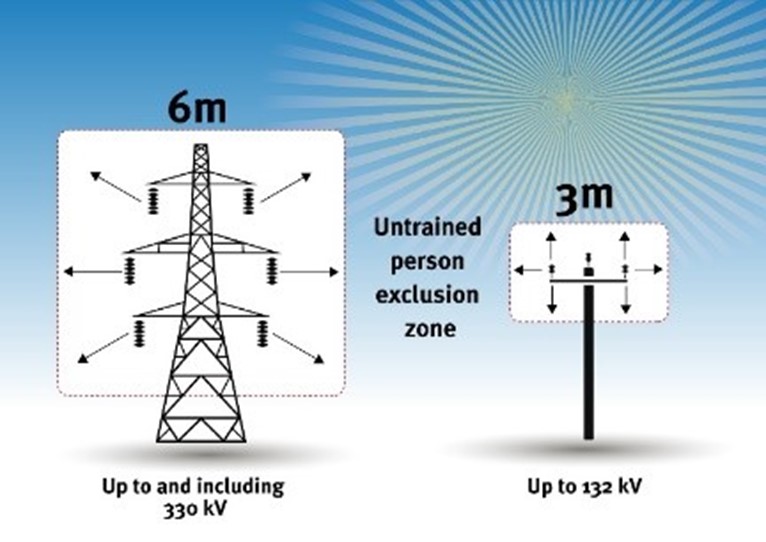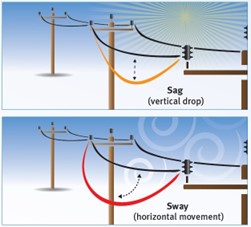Incidents involving contact with overhead powerlines
In September 2022, a worker was electrocuted when the metal frame he was holding contacted a high voltage overhead powerline at a construction site where a shed was being built.
Initial enquiries indicate the metal frame was being moved onsite by a pick-and-carry mobile crane, when the worker attempted to prevent the metal frame striking a nearby vehicle. It was not known that the metal frame had made contact with an overhead powerline at the time.
In November 2022, a worker operating an elevating work platform (EWP) sustained serious burn injuries when the EWP contacted overhead powerlines. Investigations have determined that new stainless-steel pipe works were being installed to connect a water tank to existing supplies of the workplace. It appears that the EWP operator was completing welding pipe works when the EWP was raised to full extension and contacted 11kV overhead powerlines.
In February 2023, several workers received electric shocks, one of them high voltage, when a metal street light pole contacted an 11kv overhead powerline. Early investigations found a truck mounted crane was manoeuvring the pole when for reasons yet to be established, the pole contacted the powerline.
Investigations into these incidents are continuing.
These findings are not yet confirmed, and investigations are continuing into the exact causes.
Safety issues
Contact with overhead powerlines, or coming too close to overhead powerlines, can be fatal. You don't need to come in direct contact with them to receive an electric shock. All electric line voltages are lethal, with the risk of flashover increasing as the electric line voltage rises.
The most common electrical risks associated with working near overhead powerlines are:
- electric shock causing injury or death
- arcing, explosion or fire causing burns (arcing or explosion or both occur when high fault currents are present)
- fire causing property damage.
Hazards from overhead powerlines may arise from:
- something the person is holding, or is in contact with, coming too close to the powerlines (within the exclusion zone)
- operating plant such as a crane within the exclusion zone
- building structures near overhead powerlines.
Ways to manage health and safety
Taking steps to manage risks is a condition of doing business in Queensland. Effective risk management starts with a commitment to health and safety from those who manage the business. If an incident occurs, you'll need to show the regulator that you’ve used an effective risk management process. This responsibility is covered by your primary duty of care in the Electrical Safety Act 2002 and the Work Health and Safety Act 2011.
There are duties to ensure electrical safety for persons conducting a business or undertaking, designers, manufacturers, importers, suppliers, installers, repairers, persons in control of electrical equipment, workers and others.
Where the Work Health and Safety Act 2011 and the Electrical Safety Act 2002 both apply, the Electrical Safety Act 2002 takes priority.
Use the hierarchy of controls to help decide how to eliminate and reduce risks in your place of work. The hierarchy of controls ranks types of control methods from the highest level of protection and reliability to the lowest. It’s a step-by-step approach to eliminating or reducing risks. You must work through the hierarchy of controls when managing risks, with the aim of eliminating the hazard, which is the most effective control.
Possible control measures to prevent similar incidents
Effective control measures for working near overhead electric lines are often made up of a combination of controls. This includes eliminating the risk of electric shock by turning off the power. The PCBU, principal contractor or operating plant owner should discuss options for de-energising or re-routing the electricity supply with the relevant electricity entity.
De-energising or re-routing powerlines should be arranged with the electricity entity as quickly as possible as this can take some time to arrange. Where overhead powerlines have been de-energised, confirmation should be sought from the person in control of the powerline before undertaking any work.
If eliminating the risk of contacting overhead powerlines by de-energising or re-routing powerlines is not reasonably practicable, you must consider using a combination of control measures, to minimise the risk.
If you must work near powerlines, you should follow these steps:
Develop a safe system of work before you start work
- Develop a safe system that ensures a safe distance from powerlines can be maintained at all times (stay outside the exclusion zone)
- Identify overhead powerlines by consulting maps and/or talking to the property owner and electrical entity. For Ergon Energy and Energex visit lookupandlive.com.au for your free powerline safety plan.
- Consultation regarding the work and the related risks should occur between the PCBU and the crane or operating plant operator before setting up the crane in the vicinity of overhead powerlines
- Conduct a site-specific risk assessment – you should consider:
- identifying the minimum clearance distance from the closest part of the crane or its suspended load or other operating plant to the power line
- the nature of the load to be moved, e.g. dimensions and whether the load is conductive. When in contact with high voltage material that would normally be non-conductive, the crane may become conductive. All materials should be assumed to be conductive unless a competent person can confirm otherwise
- whether the load is being carried above the electric lines and may accidentally fall onto the live lines
- unexpected movement of the terrain, ground or surface upon which the crane or other plant is located, possibly resulting in a corresponding surge or sudden movement towards live electric lines
- prevailing or unexpected wind strength and direction and other weather conditions
- the possibility of sway and sag of the overhead powerlines (sway of overhead powerlines is usually caused by wind, while sag may vary as temperatures vary)
- in the case of a crane, the size and shape of the load, particularly the surface area facing the wind
- functional behaviour of the crane, load or other plant that could result in inadvertent contact with electric lines
- possibility of crane or other plant becoming live through voltage induced by adjacent electric lines, especially high voltage lines
- how the load being carried by a crane is secured and whether any part of the load may inadvertently move during the operation and encroach on the exclusion zone.
Avoid going into exclusion zones
An exclusion zone is a safety envelope around an overhead electric line. No part of a worker, operating plant or vehicle should enter an exclusion zone while the overhead electric line is energised (live). Different exclusion zones apply depending on the level of competence, training and skills of workers and whether the worker has been authorised by the owner or person in control of the electric line to work within a closer distance. Examples include:
- Using alternative plant which cannot physically enter the exclusion zone
- Using programmable zone limiting or warning devices to prevent the crane boom or load from entering the exclusion zone, or to warn the crane operator before the boom enters the exclusion zone. If a limiting device is used, the system must be designed to ‘fail-safe’, or should generally meet a reliability level of Category 4 under AS 4024: Safety of machinery or a ‘Safety integrity level’ (SIL) of 3 under AS 61508: Functional safety of electrical/electronic/programmable electronic safety-related systems.
- Make powerlines and poles more visible. Ask your electrical entity for permission to paint power poles and/or have them install markers or flags on the powerlines to act as a visual aid to highlight the presence of overhead powerlines.
- Where possible, use insulated or non-conductive tools and equipment.
- Using ultrasonic measuring devices instead of the mechanical types for measuring heights of overhead lines.
- Where the crane or plant could enter into the exclusion zone use a safety observer to make sure you stay well clear of exclusion zones. The safety observer should not carry out other tasks or duties.
- Follow the safety advice you obtain from your electrical entity.
- Although the following are the minimum safe distances, the best way to stay electrically safe is to maintain the greatest possible distance from powerlines.
Keep your workers and contractors informed about electrical safety
- Induct and train your workers and contractors in safe work procedures, emergency procedures, and exclusion zones (Figure 1).
Figure 1: Powerline towers
Carefully plan the tasks to be completed near powerlines and work away from them whenever possible, not underneath them.
- Show your workers the safe distance from a powerline by marking it on the ground.
- Ensure people are aware that powerlines can sag or sway in hot or windy weather (Figure 2).
Figure 2: Powerlines sag or sway in hot or windy weather.
Source: Working safely near powerlines in the construction industry
- Harvesters, elevating work platforms, cranes, tippers and excavators have the potential to enter exclusion zones. Ensure operators know the maximum height and reach of machinery to be used, and the nature of the load to be moved.
The controls that are put in place to ensure electrical safety must be reviewed regularly to make sure they work effectively.
More information
- Electrical Safety code of practice 2020 - Working near overhead and underground electric lines
- Working safely near powerlines in the construction industry
- Mobile crane code of practice 2006 (PDF, 1.34 MB)
- Ergon Energy
- Energex
- Powerlink
- Look up and Live map - displays the Energex and Ergon Energy electricity networks
- Exclusion zones
- Electrical exclusion zones - Film
Support for people affected by a serious workplace incident
For advice and support:

